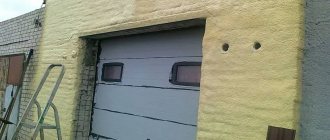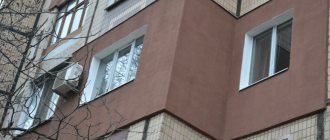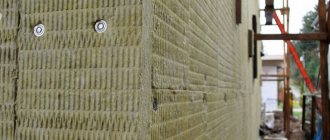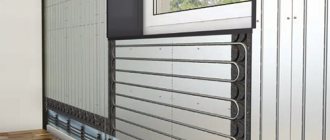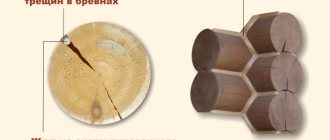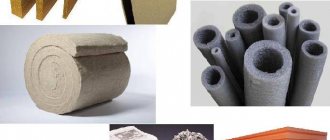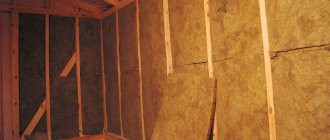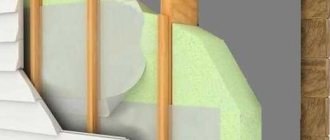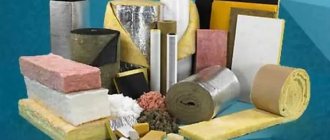The need to insulate the internal surface
If the design of a country house allows thermal insulation work to be carried out outside and inside, it is better to implement both methods. Alas, some circumstances force residents of private buildings to neglect external insulation. These include:
- location immediately behind the wall of another building or other object, the distance to which does not allow placing a layer of heat insulation;
- passage of energy cables and similar equipment along or inside walls that cannot be removed;
- the presence of an expansion joint between buildings behind the wall;
- authorities ban on modifying the façade (for example, a cultural heritage site);
- acute reluctance of residents to change the appearance of the building.
If at least one of the above conditions occurs, you can limit yourself to insulating the walls inside.
Rolled insulation under wallpaper is the best way to soundproof walls
We insulated the wall with its help and pre-treated it with an antifungal agent. This winter, for the first time ever, the wall is completely dry.
Semyon. I didn’t really trust the advertising about Polifom insulation, but I still decided to try it. The advertising still exaggerates a little. The room did not become significantly warmer, but at least it was no longer icy, so it became possible to touch the wall. In principle, I am satisfied with the result.
Video about thermal insulation material Polifom
The characteristics and features of installation by Polif are described in the attached video.
What should not be used for insulation?
Until recently, the first list included other methods of thermal insulation, but gradually they began to be abandoned, since although they allow you to retain heat, they still require more careful maintenance or regular replacement.
Among them:
- Isolon is a popular and well-known material that many have come across. But if it maintains the temperature in the room, then it is not advisable to glue wallpaper on it. Especially if you are a supporter of regular repairs. It will peel off along with the wallpaper strips and leave its parts on the walls, and then they will have to be cleaned and leveled for a long time. Not everyone wants to deal with this.
- Wood panels - in particular, laminated chipboard, some modifications of MDF. They are good as a finishing touch, especially if veneered. But it is still not recommended to glue anything on them.
What materials cannot be used
Relatively recently, a popular method of thermal insulation was covering walls with foam plastic (expanded polystyrene).
Due to its low cost, the material is often used to this day for facades, ceilings and other surfaces. However, it has huge disadvantages and is not suitable for wallpaper upholstery:
- Wallpaper glued to polystyrene foam is easily subjected to mechanical stress and comes off. This occurs due to the fact that the material does not have the required rigidity;
- To achieve the desired level of insulation, you will need a layer of foam plastic at least five centimeters thick. Such a design will not stand out aesthetically;
- during the subsequent renovation of the room, you will have to remove not only the wallpaper, but also the insulation itself. It will not be possible to remove the finishing material without damage;
- One of the important reasons why foam cannot be used is flammability. According to the rules, during installation it must be insulated with another non-flammable layer.
Insulation of walls under wallpaper with roll coverings
What will you need?
One of the most popular and widespread solutions. They are made from polystyrene. Both sides are treated with a protective coating suitable for further finishing. 0.5 cm thick, so they save space well. They provide excellent protection from the cold and resist the formation of fungus and mold. They do not require constant replacement and can easily survive several repairs.
When installed correctly, they do not peel off and help hide minor irregularities. Available only in white.
How to install correctly?
One unpleasant drawback that such roll insulation under wallpaper has is that it is advisable to glue them on flat surfaces. Therefore, installation is carried out in several stages:
- The walls are cleaned of old wallpaper and mold. Dowels, nails and other objects and fasteners are removed from them.
- A primer is applied, and specialized plaster of various colors is used for leveling.
- It takes from several hours to a couple of days to dry.
- Rolled insulation is most often attached to glue for heavy wallpaper (the surface and insulated wallpaper are coated with it), but can also be hung on tile adhesive.
- Each strip is placed adjacent to the previous one. The contact points are sealed with tape or other adhesive tape.
- Allow 72 hours to dry.
Installation features can also be found in this video:
Insulation under wallpaper: tips for choosing
The insulating layer of Polyfom under the wallpaper is made of cross-linked polyethylene foam, both sides of which are surrounded by flesh-colored paper. It looks like a mixture of foam and shaving foam. Due to the fact that paper is glued to the sides of the insulating layer, it can be glued in the traditional way for heavy wallpaper, namely: glued with glue for heavy wallpaper. Let's start with the technical characteristics of the material and move on to application.
Polyfom: technical characteristics
Dimensions: width - 0.51 m; length - 14 m; thickness - 2 mm, 3 mm, 4 mm, 5 mm, 8 mm, 10 mm, 15 mm, 20 mm; area - 7 m2; weight of 1 square meter - from 220 g; thermal conductivity coefficient - 0.038 W/mK; vapor diffusion coefficient - 0.00000000000009848 kg/msPa; tensile strength - more than 0.2 N/mm2; strength of lamination of layers of material - paper is inseparable from polyethylene foam; packaging - sold in rolls.
Application of Polifoam cross-linked polyethylene foam insulation in construction
The insulating material is used on uneven (unputtyed) surfaces, floors of any kind and type of wallpaper. You can glue wallpaper after 72 hours.
Detailed instructions for gluing Polyf under wallpaper.
Pros: thermal insulation (eliminates cold from the walls, prevents the formation of condensation and fungus on the surface of the walls), noise protection (reduces the level of extraneous noise), smoothes out uneven walls (saves money and time, avoids dust and dirt during installation).
How effective is Polifom material in combating noise from neighbors?
The effectiveness depends on the material from which the wall is made, the thickness of the wall, the size of the room on both sides of the wall to which the soundproofing layer is glued. It is important to understand and remember that it is not intended for wet areas.
For example : in a room 9 m2 from a wall made of foam blocks 15 cm wide + 1 cm plaster + a layer of Polifma 5 mm thick is glued + the seams between the strips are coated with PVA glue, the noise from neighbors has decreased by about 20 dB (you can’t hear a mobile phone ringing, you can’t hear snoring, I can't hear the TV).
How to properly glue the substrate to the wall.
Polyfoam is a fairly inexpensive, convenient, easy-to-use material that saves time.
Reviews about the material are good, I recommend it to everyone.
Functions
The substrate consists of several layers. In the middle, as a rule, there is foamed polyethylene, enclosed between layers of paper.
Many multi-apartment “anthills”, both old and new, do not have good sound insulation. Residents hear other people's conversations, and not only in raised voices, but also music and harsh sounds from their neighbors. All this is unnerving and does not allow you to live in peace. Sound insulation is ensured by using a wallpaper backing. This material also allows you to overcome the problem of indoor humidity.
It is an excellent lining for any wallpaper. Using it, the outer decorative layer is easier to glue and it will look better on the walls.
As a result, the finish will last longer and the problem of new repairs, as well as the material costs associated with it, will be postponed. Once upon a time, old newspapers were used as a backing. It was easier to glue wallpaper on them. Technology has come very far since then. Taking into account all the possibilities of modern substrates, their use cannot be considered a whim.
How to glue insulation yourself?
Any insulation for walls inside an apartment is glued almost the same way. Only the adhesive compositions that are recommended for use by the manufacturers are changed. If we put this aside, we can stage by stage the papering of a room using insulation as follows:
- The walls are cleared of old wallpaper. It is advisable to level them and apply a layer of putty.
- The surface of the wall must be treated with a primer better than deep penetration. Some craftsmen use PVA for the same purpose. A layer of glue is applied to the wall in two layers
- An adhesive composition for insulation is applied to the wall and insulation
- Glue and level the material using a roller or wallpaper spatula so that no air bubbles remain
Attention! You can glue wallpaper onto insulation no earlier than 72 hours. At the same time, humidity and temperature should remain unchanged. Drafts are not allowed!
Cost of insulation
The price range of these products may vary depending on the chosen manufacturer, as well as the material itself. Below is the average cost per item:
- Roll insulation for wallpaper, price varies from 800 to 1000 rubles. total area 5 sq.m.
- Cork insulation. Depending on the thickness, the cost of the product varies from 800 to 6000 rubles.
- Polyph. 1100 rub., per package. Total area 7 sq.m.
The most widespread among all the presented materials was the polyphome. It is easier to glue it to the wall, and if you follow all the manufacturer’s recommendations, it perfectly insulates the walls of the room.
Reviews about polyfom wallpaper insulation
Lena. The outer wall in the kitchen was constantly damp. What my husband and I haven’t tried. Friends recommended Polif. We insulated the wall with its help and pre-treated it with an antifungal agent. This winter, for the first time ever, the wall is completely dry.
Semyon. I didn’t really trust the advertising about Polifom insulation, but I still decided to try it. The advertising still exaggerates a little. The room did not become significantly warmer, but at least it was no longer icy, so it became possible to touch the wall. In principle, I am satisfied with the result.
Why do you need to insulate walls under wallpaper?
The issue of thermal insulation of interior and inter-apartment floors arises in several cases:
Insulation is necessary when concrete slabs or brick structures freeze, there are microcracks and other damage that negatively affects living conditions. The insulation system prevents the formation of fungus, mold, and the appearance of black spots. Raises the average temperature in the room by several degrees. Acts as an additional leveling of the surface, which is especially important in apartments with uneven walls. Reduces humidity levels, which also prevents the spread of bacteria. Additionally, it suppresses noise, which has a beneficial effect on the overall emotional state of homeowners. Reduces heat loss and makes it possible to save on space heating in winter.
Insulation for wallpaper: characteristics of popular types
You can insulate the walls in your apartment with special materials intended for subsequent wallpapering.
Cold walls in an apartment do not bring joy to anyone. The situation can be corrected quite simply. To do this, you just need to stick a special insulation on the wall in front of the wallpaper, with which we can achieve the following results:
- Elimination of dampness and its consequences: fungi, mold, etc.
- Warming the room. The temperature rises approximately 1-2 degrees
- Correcting wall irregularities. After gluing the insulation under the wallpaper, minor defects are hidden under a layer of heat-insulating material
- Ability to perform work independently. Pasting walls with insulation has its own nuances, but basically it is carried out identically to how wallpaper is pasted
Which wallpaper to choose for warmth in the apartment
But not only with the help of special insulation can you maintain a comfortable temperature in the apartment, but also with the help of the latest thermal wallpaper. This is a modern material that perfectly protects space from heat loss. Due to sophisticated production technology, they have a denser structure. They come in a variety of design options and can be a great addition to almost any interior.
They consist of two elements - a substrate and a top layer. The bottom one is made of thin polystyrene or cork, the second one is made of vinyl, non-woven fabric or paper.
Advantages and disadvantages of thermal wallpaper
Among their advantages it is worth noting:
- They are not afraid of humidity.
- Mold and mildew do not form on them.
- They are strong and difficult to scratch or damage.
- Installation is relatively simple and not complicated.
- They do not harbor insects.
- They do not emit unpleasant or pungent odors.
The main disadvantage of this material is its high cost. It will be expensive to decorate an entire room or apartment with them, but at the same time, such coverage is a profitable investment that does not require regular replacement. Only if you yourself do not like frequent changes.
Another disadvantage is flammability, but manufacturers are constantly updating the composition and new products are less susceptible to fire.
The third drawback is that they do not stick to a perfectly flat surface. But this is also different from many standard types of wallpaper.
How to glue thermal wallpaper?
They stick about the same as regular ones. The only difference is the type of substrate - for cork you need a special composition, for polystyrene standard solutions will also work.
- The surface is cleaned and, if necessary, covered with plaster.
- Treated with primer.
- Sections of wallpaper and walls are coated with glue.
- The piece is glued to the desired location.
- Three days are allowed for complete drying.
You can get acquainted with the installation features in this video, where plaster is used as an adhesive base, which is also suitable for attaching similar insulating materials:
It is important to remember that all types of wallpaper and insulation are installed in a closed, warm room. Ventilation, especially drafts, are unacceptable
It is also worth considering good ventilation for the room in advance, because if a lot of moisture accumulates in the space, then the entire effect of any insulation will be lost and the room will freeze.
Types of insulation
To insulate walls under wallpaper, three main types of materials are used:
- roll insulation made of foil foam plastic;
- cork mats (or rolls);
- plaster.
Each material has its own advantages and disadvantages, and their characteristics differ slightly.
Plaster mortar
Conventional plaster based on sand, cement and water can only level the wall. It does not have heat-insulating properties. In order for the usual material to become insulation, various substances that have the ability to retain heat are added as a filler, in addition to sand.
The cheapest will be small sawdust. However, this is not the best solution for two reasons:
- the thermal insulation properties of sawdust are low;
- sawdust absorbs water vapor, and mold can grow deep in the coating.
Plaster mortar with the addition of glass microgranules, the so-called “foam glass,” is widely used. The granules retain heat well; the solution is applied in a layer of up to 5 cm, which allows you to hide significant surface irregularities underneath.
Foam glass - an insulation option for walls under wallpaper
Compositions with expanded polystyrene granules are also used. They not only retain heat, but also have excellent sound insulation properties. There is only one disadvantage of foamed plastics - when burned, they release harmful substances.
Another group of fillers is vermiculite and perlite. These substances are of mineral origin and have high thermal insulation characteristics. The disadvantage is that it is hygroscopic; you will have to resort to additional waterproofing measures.
For all materials - fillers, there is one general limitation for independent use - plastering work requires certain qualifications and proven work skills. Carelessly applied plaster can simply collapse along with the wallpaper; if the layer is thick, it can cause injury to people nearby.
The surface of the wall after plastering with a composition with granular filler will not be smooth enough for wallpapering, so it will have to be additionally primed.
This type of insulation should be chosen by those who are confident in their abilities and have experience in plastering wall surfaces.
Cork insulation
Cork insulation occupies a special, elite position among other materials. Cork has excellent thermal insulation and sound insulation properties; it can mask minor wall irregularities.
Cork is environmentally friendly, does not absorb moisture and does not emit toxic substances when heated.
There is perhaps only one drawback to cork: it is very expensive. A special adhesive composition for working with cork is also expensive; ordinary wallpaper glue will not be able to withstand dense and heavy sheets.
Cork is supplied in both sheets and rolls. It makes more sense to use rolls for well-leveled surfaces. Separate sheets - for walls of complex configuration, with architectural projections and niches. The thermal insulation properties of both forms of release are identical.
Roll insulation
A thin layer of foil or impregnated paper is applied to the layer of foamed plastic in such insulation. Foil reflects heat back into the room, and paper adheres better to the wall surface. Special materials are produced, covered with paper on both sides - they are easiest to glue to the wall, and wallpaper can be glued directly to the inner paper layer.
The most common type of roll insulation for plastered walls is Polyfom. It is made of polyethylene foam and has excellent thermal insulation and sound insulation properties. Through an external wall covered with such material, street noise is practically inaudible. In terms of price, it is one of the most affordable.
Politom - a variant of insulation for walls under wallpaper
The disadvantages of Polyfom include the following factors:
- flammable, releases toxic substances when heated to high temperatures;
- requires careful leveling and grinding of the surface, transfers all the unevenness of the underlying surface;
- The gluing composition dries for at least three days.
It is strictly not recommended to glue wallpaper until completely dry. It can come off the wall along with the thermal insulation layer.
Available in rolls 0, 5 and 1.2 meters wide, 2-5 mm thick. Laminated paper is produced on both sides.
Expanded polystyrene, known by the common name polystyrene foam, is also available in thin sheets for wallpapering walls. The granules in it are slightly larger than in the filler for warm plaster. It has average thermal insulation properties and is one of the cheapest materials. Its disadvantages are the following:
- flammable, releases toxic substances when heated to high temperatures;
- poor adhesion to wallpaper, it is better to buy tiles covered on one side with paper in the factory;
- low strength; if the wallpaper is hit by a heavy object, it may become deformed and the wallpaper will rupture.
Special mention should be made of such roll material as wallpaper with an insulating layer. It simultaneously serves as both insulation and finishing. A layer of foil or non-woven material like thin interlining or spunbond is used as an insulating layer. The undoubted advantage of such insulation is the great time savings - both operations are performed in one sticker. The disadvantages of insulated wallpaper include:
- reduced strength;
- small variety of colors and textures.
Often such wallpaper is purchased white with the expectation of subsequent painting.
Insulation with mineral wool under wallpaper
Required materials and cost
Basalt slabs are often used for finishing houses and residential premises. Known for its insulating properties:
- Retains heat perfectly.
- Does not freeze even in severe frosts.
- Completely safe for humans.
- Not subject to rotting.
- Not flammable and does not ignite from an open flame.
- Does not emit pungent, unpleasant odors.
- Does not wrinkle over time.
- Produced by many brands and sold at relatively affordable prices.
One drawback is the thickness of this material and the need to hide it under thin plasterboard slabs. In total, such finishing can eat up from 4 to 10 or more centimeters near each wall. Not everyone will agree to sacrifice free space.
Installation features
Another advantage of mineral wool is that old coatings can be left on interior floors, but only if the surface is fairly flat. If not, it is advisable to level it using special plaster.
- The work area is prepared, nails and dirt are removed, mold is treated with special compounds.
- Metal or wooden guides are placed at equal distances. It is advisable to give preference to steel or aluminum profiles. They take up less space and are easier to attach.
- Layers of mineral wool are laid between them - it is sold in cut layers, which greatly simplifies installation.
- Basalt sheets are fixed using special plates located on the guides. Moisture insulation, represented by a thin woven film, is placed.
- Drywall or chipboard is mounted on top, but the latter is much less common.
- The seams are treated with plaster, leveled and smoothed.
- After drying, any wallpaper can be glued to the surface.
You can learn more about the features of installing mineral wool in this video:
Possible insulation options for wallpaper
The most popular are three types of insulation for wallpaper. Below are their performance characteristics and costs. It is these criteria that should be taken into account when choosing this product.
Roll insulation for wallpaper
For its production, heat-insulating material is used, which on one side has a reinforcing base made of paper or foil.
This insulation with foil, the use of which is extensive, is also called foil insulation.
Additional layers achieve different goals. This way the foil reflects heat better. Paper provides better adhesion to the wall surface. By the way, some types of roll insulation for this purpose have a paper coating on both sides.
Poliform - insulation for wallpaper
It is made from polyethylene by foaming the latter. This insulation in its structure resembles heavy wallpaper. For ease of use and better adherence to the surface, it is covered with paper on both sides.
Pasting walls with Polyf can be done independently, but you will need to follow certain recommendations. The walls must first be leveled.
The peculiarity of this material is that with high-quality gluing, all irregularities, pebbles and debris will be clearly visible after wallpapering the wall.
Drying time is at least 72 hours. Only after this is it possible to begin further work.
This material is worth choosing if there is no desire or opportunity to level the walls. It perfectly hides all surface imperfections, and also has high thermal insulation properties.
The disadvantage of the latter is that to paste a room with it, you will need to use special adhesives. Regular glue for heavy wallpaper will not work.
Attention! When choosing insulation for wallpaper, you should take into account: the cost of the product, its thermal insulation properties, whether it will be possible to glue the insulation yourself or whether you will need professional help.
Features of cladding the internal surface of the house
The impossibility of external thermal insulation of walls is in itself a disadvantage of the structure. To it you can add the following disadvantages of the lining inside:
- reducing the usable area of the room (in the case of insulation of the floor and ceiling, also the volume);
- although the temperature becomes higher, heat does not accumulate in the walls - they remain cold;
- the previous fact contributes to the formation of condensation, causing dampness, mold, corrosion, and the appearance of microorganisms.
Fortunately, there are also advantages, and the main one is the normalization of the indoor microclimate.
Distinctive features of the internal thermal insulation of the walls of a private house, regardless of the material of the latter, are:
- The presence of two additional layers - hydro- and vapor barrier. The first reduces the likelihood of moisture getting on the insulation from the outside, the second - from the inside (from the side of the rooms).
- Rapid change in room temperature when opening vents, windows, doors.
- When using some insulation materials, “cold bridges” may appear - sections of the walls where condensation with cold air is concentrated.
- If possible, it is worth using environmentally friendly material for interior cladding.
- You can save money on wall insulation, which cannot be said about exterior work.
- Carrying out work inside the house in comfortable conditions all year round - the process will not be affected by natural factors.
- The presence of assistants is not necessary - all stages can be easily completed independently.
Important requirements are imposed on the structure at the preparatory stage of interior cladding. The key one is maximum dryness of the walls.
Possible insulation options for wallpaper
The most popular are three types of insulation for wallpaper. Below are their performance characteristics and costs. It is these criteria that should be taken into account when choosing this product.
Roll insulation for wallpaper
For its production, heat-insulating material is used, which on one side has a reinforcing base made of paper or foil.
This insulation with foil, the use of which is extensive, is also called foil insulation.
Additional layers achieve different goals. This way the foil reflects heat better. Paper provides better adhesion to the wall surface. By the way, some types of roll insulation for this purpose have a paper coating on both sides.
Poliform - insulation for wallpaper
It is made from polyethylene by foaming the latter. This insulation in its structure resembles heavy wallpaper. For ease of use and better adherence to the surface, it is covered with paper on both sides.
Pasting walls with Polyf can be done independently, but you will need to follow certain recommendations. The walls must first be leveled.
The peculiarity of this material is that with high-quality gluing, all irregularities, pebbles and debris will be clearly visible after wallpapering the wall.
Drying time is at least 72 hours. Only after this is it possible to begin further work.
Technical characteristics of Polyfom
This material is worth choosing if there is no desire or opportunity to level the walls. It perfectly hides all surface imperfections, and also has high thermal insulation properties.
The disadvantage of the latter is that to paste a room with it, you will need to use special adhesives. Regular glue for heavy wallpaper will not work.
Attention! When choosing insulation for wallpaper, you should take into account: the cost of the product, its thermal insulation properties, whether it will be possible to glue the insulation yourself or whether you will need professional help.
You can also use polystyrene foam as insulation for walls, which is described in more detail here. However, it is best used for thermal insulation of walls outside or for insulation of facades of buildings and structures.
How to glue correctly
Practice shows that wallpaper backing adheres remarkably well to concrete, wood, plywood, and drywall. In order to firmly glue it to the surface, you need to prepare the walls themselves for this: tear off the old wallpaper, remove any remaining paint, level out the depressions and seal the cracks with putty or cement mortar. Then you need to prime the surface. PVA glue or some other similar composition will do for this.
The backing strips themselves must be prepared for sticking to the walls in advance. They cut very easily. They must be divided into sheets taking into account the height of the walls and these sheets must be allowed to align.
Smooth sheets of material are coated on the inside with PVA glue or glue that is used for heavy wallpaper or under polystyrene. If there is a high level of humidity in the room, use baguette glue or liquid nails. (This, of course, will be more expensive, but you can be sure of the quality of the repair).
Taking all this into account, you need to act so that the glue does not get on the joints. Otherwise, the pieces of the backing will stick together and the seam between them will be uneven. The canvases with the applied glue are left for five to ten minutes, and then they are glued to the walls joint to joint - just like most modern wallpaper. In this case, the wall must also be coated with the same glue before this. Note that if the outer layer of the backing is non-woven and not paper, then only the wall itself needs to be coated with glue.
The gaps between the canvases must be sealed with paper tape or paper tape. To ensure that the result does not disappoint, just as in the case of wallpapering, drafts should be avoided. Experienced people advise carrying out the work itself at temperatures above +10 degrees and humidity less than 70 percent. If the room is cold, the glue will not set, but if, on the contrary, it is too hot, it will dry very quickly, and you may not have time to fix the entire substrate on the wall. Some areas will not be glued. Taking these features into account, it is recommended not to undertake such repairs in the spring or autumn, when there is high humidity and strong temperature changes.
Wall mounting
Despite the fact that roll insulation is created from different materials, it is mounted on the wall according to the standard principle. All differences will lie in the composition of the glue that will be used, and, accordingly, in the drying time of the substrate on the wall.
Conditions for carrying out installation work with the substrate indoors
To glue insulation to the walls of your apartment, you have to do the following:
- First of all, it is worth preparing the surface, for which you need to remove the old wallpaper, plaster the wall, smoothing and sealing large cracks and irregularities. Small defects in the wall surface can be left, they will be closed.
- Next, the surface of the wall must be primed. This is done either using glue, which we will use to glue the substrate, diluted in a weaker consistency, or using a special primer composition. After priming, you need to wait until it is absorbed into the wall and dries.
- It is recommended to cut the rolled insulation into pieces of the required length in advance so that it can lie down and level out. This will make gluing it up a lot easier for us. When cutting the canvas, add a little material for insurance.
- We prepare the adhesive composition according to the instructions on its package. If we are dealing with a substrate with a top layer of paper, then we apply glue to the wall and to the cut pieces, and let them soak in the composition for literally 5 minutes. If the backing is equipped with non-woven edges, then it is enough to smear the wall, and the material will easily attach to it.
- Next, we proceed directly to installing the paintings on the walls. This process is reminiscent of wallpapering; the pieces are also glued together and carefully smoothed out. The air is expelled from under the canvas and it sticks firmly to the wall. It is convenient to use a rubber roller; it will create the necessary pressure and will not damage the insulation material.
- After the insulation has dried, after about 1-3 days, we seal the joints of the panels with ordinary masking tape. Krepp will allow us to give solidity to our structure.
- Now our walls are well insulated, and we can proceed directly to gluing the wallpaper itself.
Wall insulation will allow us to create the most comfortable living conditions. It will serve us for a long time, no matter how long any wallpaper hangs.
Related article: Do-it-yourself TV wall mount
